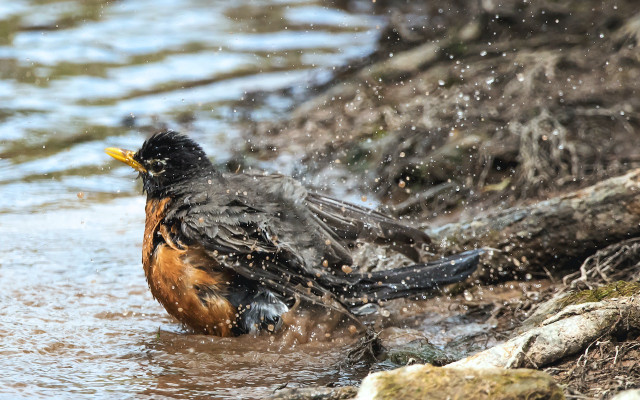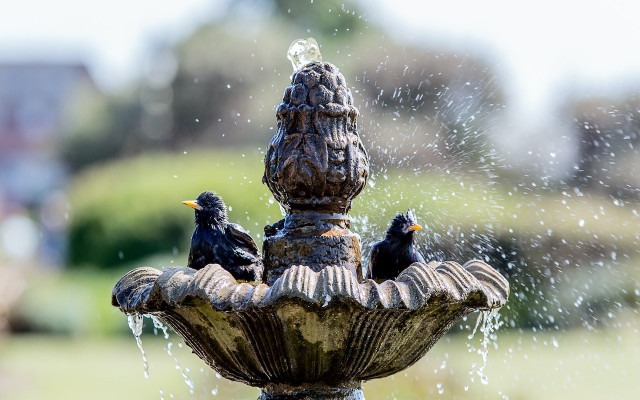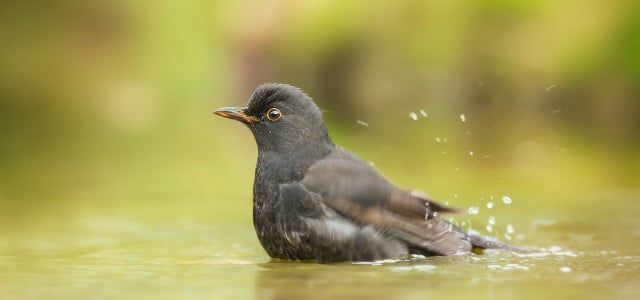When it’s hot and dry, birds need to drink more – just like us. We’ll look at how to provide water for birds in the forms of birdbaths and feeders. A little effort on our part goes a long way.
Birds need to drink twice a day to stay hydrated, but finding suitable watering holes is not always easy. In the summer, most puddles and ditches dry up quickly, and in the winter they can turn to ice.
With these tips, you can help provide water for birds that live in your neighborhood. And if you want to go the extra mile, you can spoil them even more.
Why Birds Need Water
Water is just as important for birds as it is for people. Like us, birds need water to stay hydrated, but they also use it for bathing. Birds need to dampen their feathers to help loosen any dirt that may have collected in them, and it also makes their feathers easier to preen. Preening is important because it distributes oil over the feathers, making them waterproof and providing an insulating layer to keep the bird warm.
Did you know bees also need water? Read more here: Bees Need Water – Help Them out with a DIY Bee Waterer
Finding the Right Birdbath

When it comes to a watering-place, birds aren’t fussy. You don’t need to buy a birdbath to provide water for birds; you can make one yourself instead.
Shallower vessels with flat edges, like old serving platters or fruit bowls, are ideal. They enable the birds to reach the water without slipping. To attract different types of birds, the water should be between ½ inches and 4 inches deep.
Water for Birds: Choosing the Right Location
Water for birds in man-made birdbaths and feeders will only be used if it seems safe to them. It’s best to place your birdbath in a place where the birds can easily observe their surroundings. Ideally, you should place your birdbath:
- off the ground, slightly elevated
- approximately 10 feet away from bushes, so enemies can’t sneak up on them
- near a tree, so the birds can quickly get to safety if needed
- in an open space, so cats and other predators have no place to hide.
Birds Need Clean Water



If you want to provide water for birds in your backyard or on your balcony, it’s important to change the water regularly, to keep it clean. Bacteria like salmonella can quickly build up in small watering holes, making the water potentially deadly for birds. Replace the water daily on hot summer days, and once a week during the colder seasons. Remember to clean the container with only hot water and a brush – never use chemical cleaners as birds are very sensitive.
Remember: Empty and cover your birdbath when you go on vacation. If the water isn’t changed regularly, it could do more harm than good!
Additional Luxury: Sand Bath
Setting out water for birds goes a long way to help our feathered friends. But birds also like to bathe in sand to rid their feathers of parasites, and sand can be even harder to find than water. So if you’re feeling extra generous, set up a sand bath for the birds. All you’ll need to do is fill a shallow bowl or hole in the ground with fine sand.
Again, it is important that you choose a safe place. To prevent pathogens from accumulating in the sand, you should replace it every few weeks.
Birdbath Winter Care
Some birds don’t fly away for the winter. If you have a birdbath in the summer, you should leave it in place throughout the winter. In the cold months, setting out water for birds is especially important because birds eat more dry grains in the winter and get less water from their food sources. Additionally, depending on your region, many natural water sources freeze or are covered in snow and leaves. Keep your bird water ice-free with the following tips:
- add a light ball to your bath that can move with the wind, this can help prevent it from icing over
- pour boiling water on the ice to melt it
This article has been translated from German by Karen Stankiewicz. You can find the original here: Vogeltränke und Vogelbad aufstellen: So bereitest du den Tieren eine Erfrischung
** Links to retailers marked with ** or underlined orange are partially partner links: If you buy here, you actively support Utopia.org, because we will receive a small part of the sales proceeds. More info.Do you like this post?






